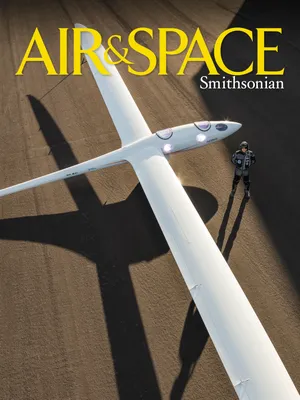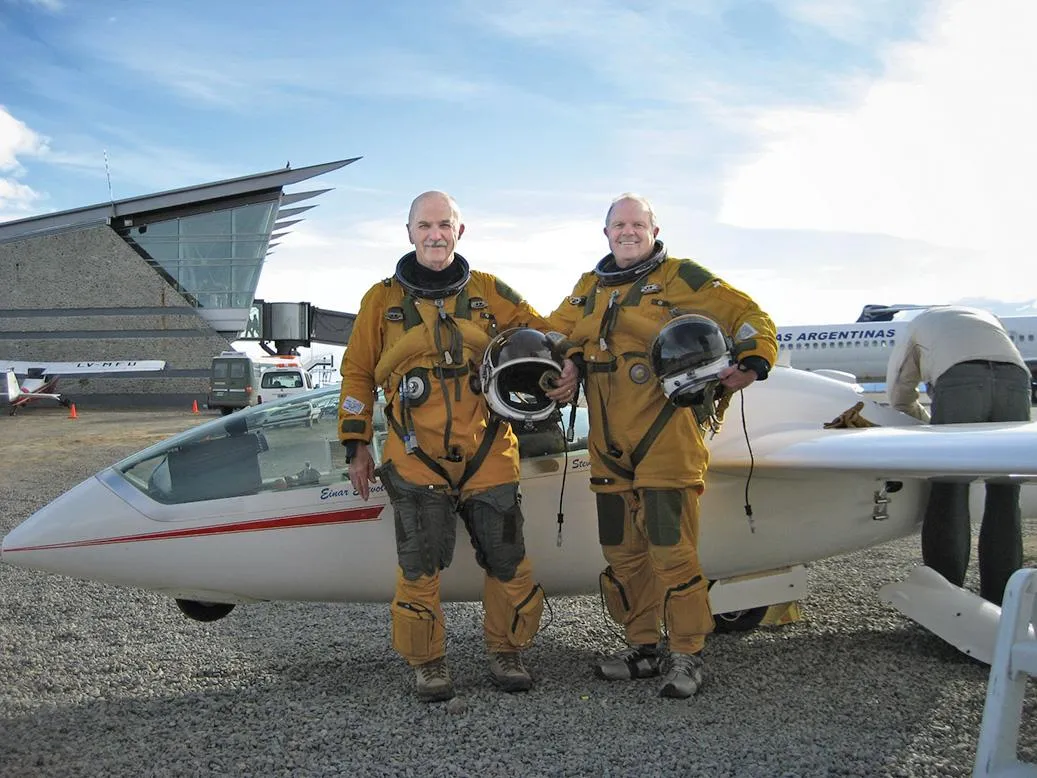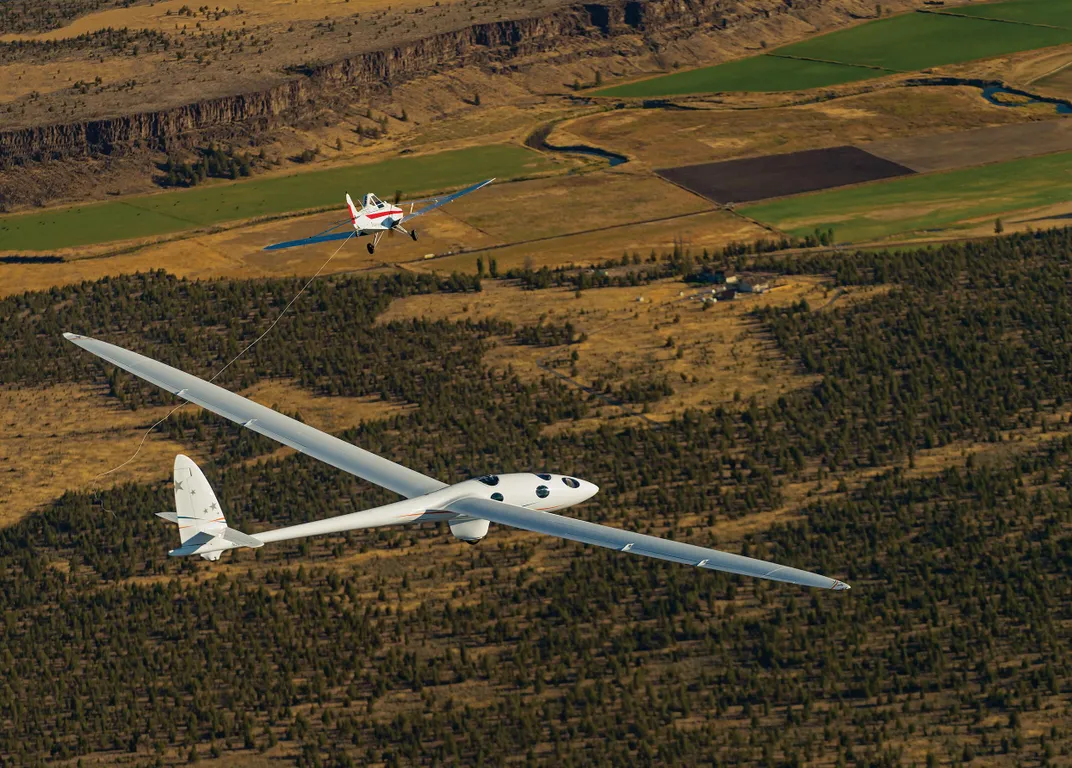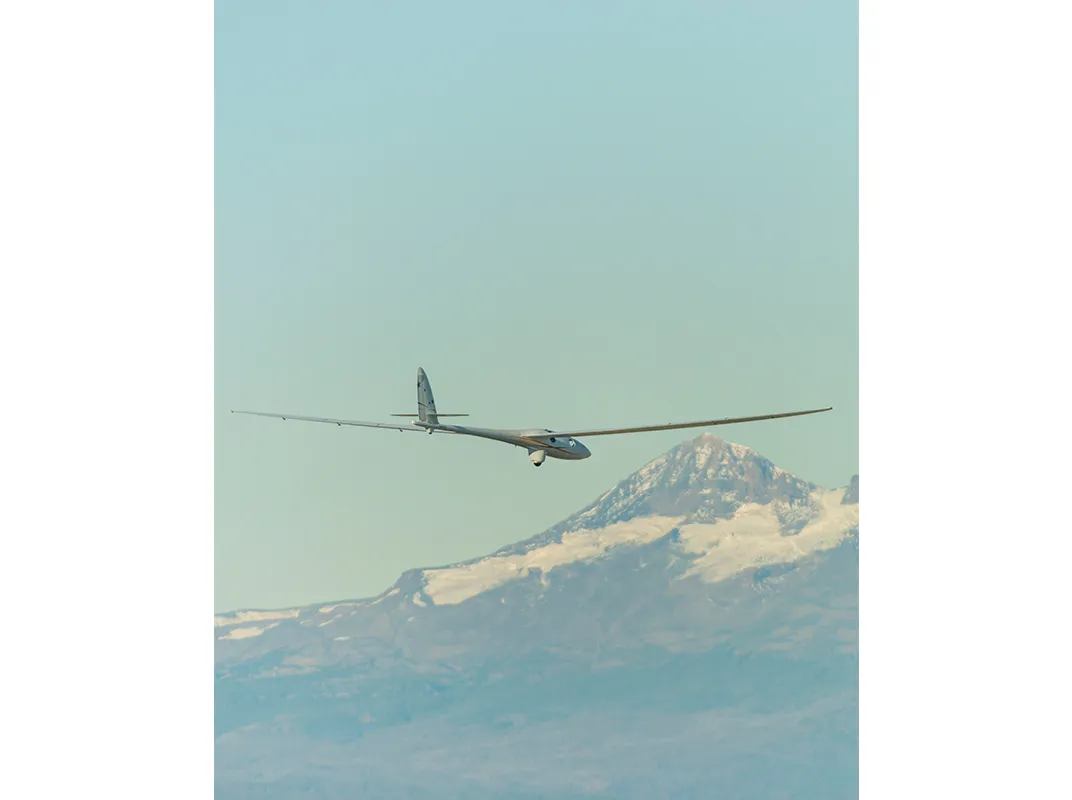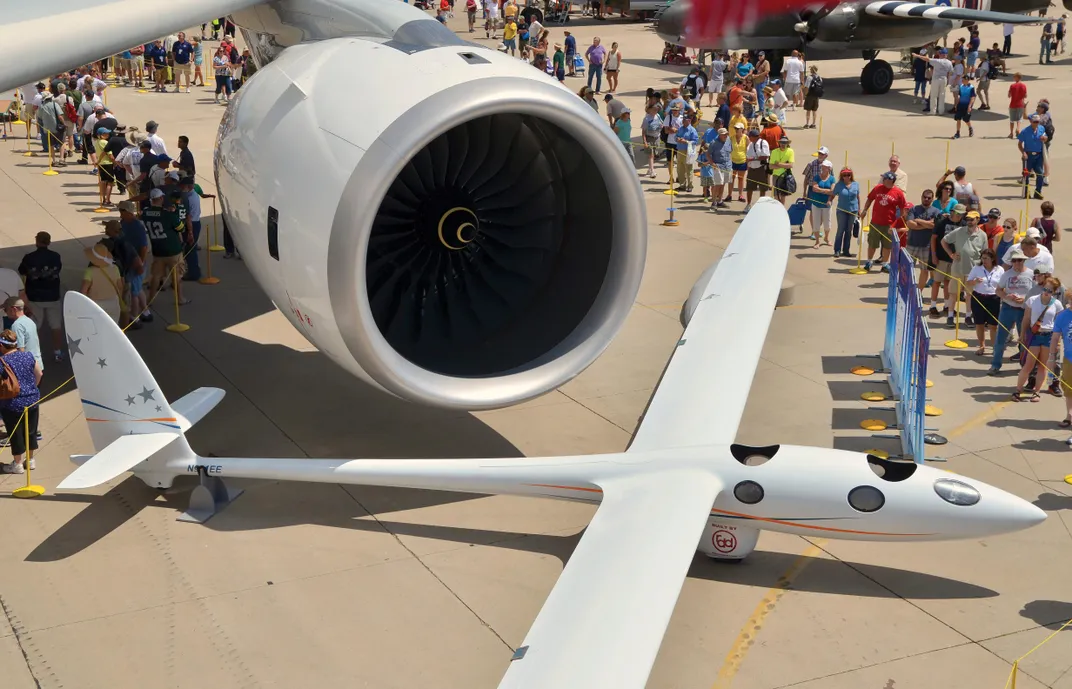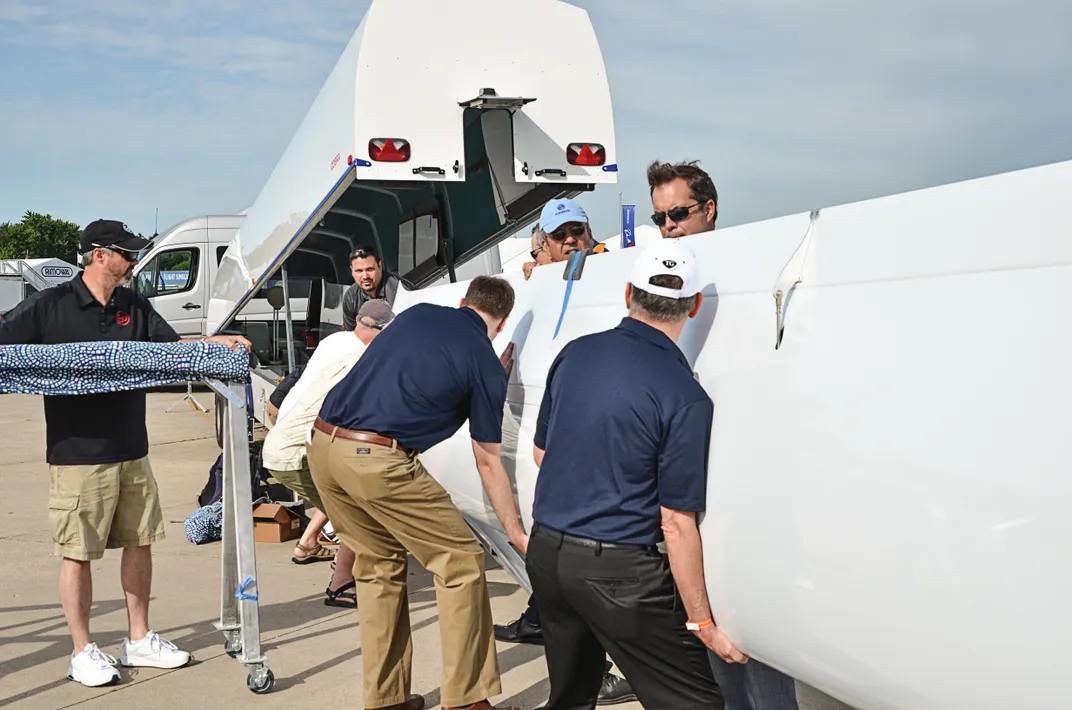Sailplane to the Stratosphere
Perlan 2 goes for 90,000 feet.
:focal(530x265:531x266)/https://tf-cmsv2-smithsonianmag-media.s3.amazonaws.com/filer/3b/80/3b809c3a-40a8-491a-ad34-73707ba41a1e/07h_jj2016_payne_e5c2434_live-wr2.jpg)
A wall of cloud runs above the eastern slope of the Carson Range, which looms over the town of Minden, Nevada, about an hour south of Reno. The wall runs the length of the ridgeline that stretches south toward the desert cities of Palm Springs and Las Vegas. A broad expanse of brilliant blue sky separates it from another wall of cloud running parallel. Stretching from the California border across central Nevada is a series of cloud lines, like waves rolling toward the shore, accompanied by vicious winds. Airliners approaching Reno report severe turbulence, and most small aircraft are staying on the ground. For pilot Tim Gardner, however, the weather is perfect—ideal conditions for high-altitude soaring. “It’s killing me not to get up there,” he says, but the glider he’s learning to fly, Perlan 2, is not quite ready.
When it is ready, Perlan 2 will attempt what no glider—what no piloted aircraft—has ever achieved: sustained flight at 90,000 feet, far into the stratosphere and near the vacuum of space. To get there the sailplane will ride stratospheric mountain waves, prodigious currents of air created by winds that sweep over mountains. The highest known waves rise up over the Andes in southern Argentina and interact with the polar vortex, the giant cyclone of air that swirls around the poles. In the rarefied atmosphere 90,000 feet up, the air density is just two percent of what it is at sea level, and about the same air density as on the surface of Mars. At such heights, an aircraft can maintain lift and power only if it is very light or very fast. A handful of pilots have “zoomed” fighters or X-planes to above 100,000 feet by using ballistic trajectories like that of an artillery shell, but for level flight, the current record by a piloted aircraft is 85,068 feet, set in 1976 by an SR-71 Blackbird spyplane, the world’s fastest jet aircraft.
The Perlan Project (so named for the pearlescent stratospheric clouds in Scandinavia) is the brainchild of Einar (pronounced “Ay-nar”) Enevoldson, a former test pilot for the Royal Air Force, U.S. Air Force, and NASA. He’s piloted dozens of aircraft, including the F-86, F-14, and F-111. He’s also flown one-of-a-kind experimental craft, among them the odd, oblique-wing AD-1 and the X-24B lifting body. During the golden age of flight research, Enevoldson was a member of the elite community that included Chuck Yeager, Scott Crossfield, and other luminaries pushing the bounds of aviation.
Enevoldson retired from NASA in 1986 and went to work as a test pilot for Grob Aircraft in Germany, where he flew the Strato 2C, a high-altitude research aircraft developed by the German Aerospace Research Center, DLR. That project was canceled, but the work piqued his interest in high-altitude flight. He recalls walking down a corridor at DLR’s offices near Munich in 1992 and noticing an image tacked outside the office of an atmospheric researcher. Made with LIDAR (light detection and ranging), the image showed what Enevoldson recognized as mountain waves, but these were far bigger and extended much higher than any he had seen before. Standing in front of the image, Enevoldson immediately saw the potential to do something unprecedented. He realized that if the waves were associated with enough wind, they could propel a glider to heights previously thought unobtainable. “I really thought at this moment that this could end up being my life’s work,” he says. High-altitude glider pilot Doug Perrenod, a Perlan project team member, says the realization was the project’s eureka moment.
Mountain waves can be compared to water in a stream swiftly running over a boulder. Air is a fluid, and once winds crest over a mountain ridge and roll down the mountain’s other side—the lee side—they push up into a wave. With the right conditions, the wave can rise thousands of feet higher than the summit of the mountains.
The presence of the waves are often indicated by clouds that are lens-shaped, or lenticular. Early aviators quickly learned to avoid flying near or under the convex clouds because they are associated with severe turbulence and downdrafts. But as far back as the 1930s, glider pilots discovered they could use the powerful updrafts to climb to great heights.
In the late 1940s, a community of soaring enthusiasts sprouted up in the central California town of Bishop—not far from Minden—drawn by the town’s proximity to the 14,000-foot-high Sierra to the west and the winds sweeping in over the range from the Pacific Ocean. Bishop became the center of the first scientific study of mountain waves. The Air Force-sponsored Sierra Wave Project enlisted atmospheric scientists, meteorologists, aeronautical engineers, and glider pilots to study the structure and behavior of mountain waves. Routinely flying above 40,000 feet, the gliders set a succession of records, and the study found that mountain waves, or a series of them, could reach above 45,000 feet with vertical wind speeds of 5,000 feet per minute, up or down. The wind rotors beneath the waves, like the hydraulics in a boulder-filled river, sometimes formed an uninterrupted wall of turbulence. The study provided the first comprehensive documentation of the hazards of mountain flying, and the findings were widely distributed to pilots.
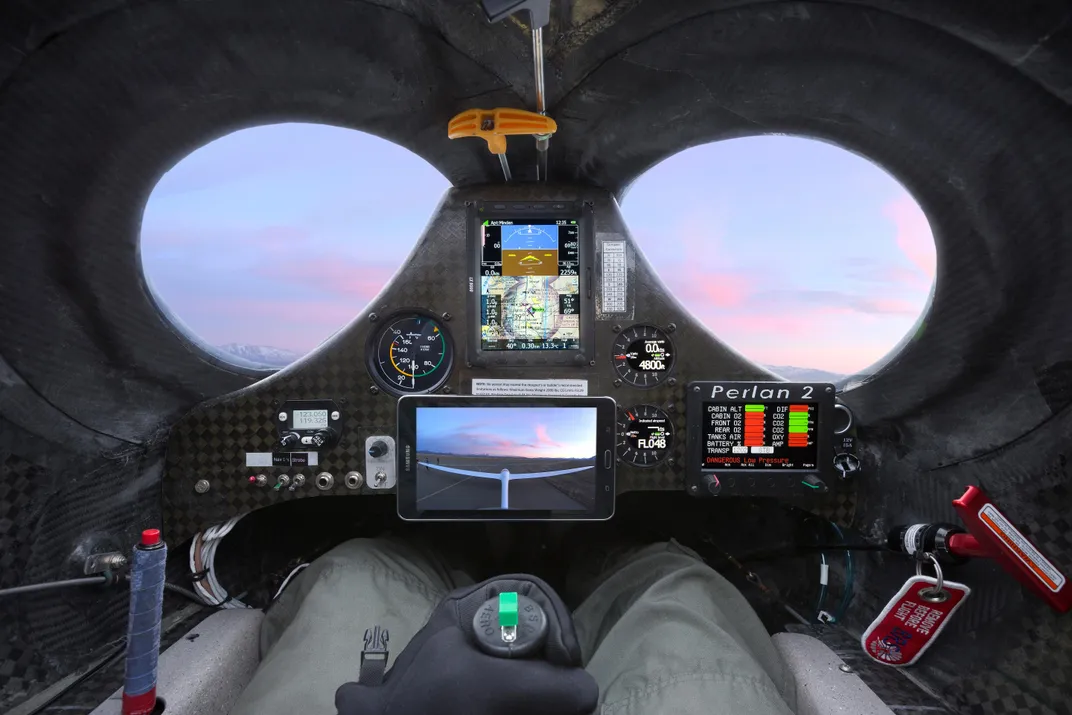
The soaring community gathered near the Sierra Nevada has grown since the 1940s; on a day of strong thermals, there may be 20 gliders flying. “Here at Minden, where we live, in the summertime it’s not uncommon for thermals to go to 18,000 [feet],” says Perlan chief pilot Jim Payne. “We regularly go to 25,000 in a mountain wave. That’s normally kind of a limit because we don’t have pressurization and high-tech oxygen systems.” Payne is one of the world’s most experienced glider pilots: He has set a number of speed and distance records, and in 2001 the Fédération Aéronautique Internationale recognized him with its most prestigious gliding award. In the 1980s, he piloted a high-altitude glider as part of the U.S. Air Force’s Soar Eagle project to demonstrate that aircraft can fly at 50,000 feet (they didn’t quite make it).
Although climbing to high altitudes is common in the Minden community, it is relatively rare elsewhere: National and international organizations give out “lenticular pins” to glider pilots who reach 25,000 feet; higher altitudes bring additional recognition. “In the course of history I think they’ve given out like 1,200 of those,” says Payne. Given the number of glider pilots, “that’s actually a small number,” he says. (The sport reaches back to the 1920s; as of 2011, according to Gliding International, there were more than 110,000 glider pilots.) Payne met Enevoldson when the latter was at NASA’s Dryden Flight Research Center in California—not far, by air, from Minden.
After his epiphany, Enevoldson began studying stratospheric mountain waves. He learned from atmospheric balloon experiments that all stratospheric waves occur within an arc 35 to 40 degrees from either pole. In 1998, a mutual friend put Enevoldson in touch with Elizabeth Austin, an atmospheric physicist studying the structure of the polar vortex. Austin theorized that during polar winters, the polar night jet, a narrow band of winds with speeds greater than 260 mph, would interact with the stratosphere, and under certain conditions allow mountain waves to propagate as high as 130,000 feet—far higher than anyone thought possible. Austin and Enevoldson began scouring maps, searching for places where conditions for stratospheric waves would likely exist. “We looked at Russia,” Austin recalls. “We looked at Sweden. We looked at Alaska.” But in each case the surrounding landforms tended to dampen the intensity and endurance of the effect. Austin and Enevoldson turned their attention to the southern hemisphere, where mountain ranges surrounded by wide stretches of open water could be found. The team finally discovered El Calafate, a quiet town in Argentina on the eastern edge of the Andes Mountains, surrounded on three sides by a freshwater lake and lacking the topography that interferes with wave propagation.
**********
In 2006, after attempts in California and New Zealand, Enevoldson and Steve Fossett, a pilot and financier, traveled to Argentina and set a world altitude record in a modified Glaser-Dirks DG505M glider, dubbed Perlan I. “Little by little we kept inching our way upward,” Enevoldson recalls. After nearly five hours, they had reached 50,727 feet and were still climbing steadily at 300 feet per minute. “We could have kept going,” Enevoldson says. But by that time “we were both really cold and tired. Steve said we had proved what we had come to prove. We were 17,000 feet above the tropopause. So we agreed: Let’s go home.” Upon landing, the group turned to the planning and design of Perlan 2.
Greg Cole, founder of Windward Performance in Bend, Oregon, designed the aircraft. Despite its extraordinary mission, Perlan 2’s dimensions—33 feet long and 84 feet in wingspan—make it a large glider, but not the largest, similar in size to other high-performance gliders. Like many other modern sailplanes, it is built of carbon fiber, so it is light (just 1,700 pounds, including pilots) but strong enough to withstand the severe turbulence it may encounter.
Perlan 2 is built for altitude. “Everything you do when you design an airplane is a compromise,” says Payne. “The Perlan 2 airfoil is optimized for about 60,000 feet.” A typical glider is optimized for about 7,000 feet. “[Perlan is] not as good at low altitude as a racing glider, but at higher altitudes it becomes very good, and at very high altitudes, a racing glider’s airfoil would be so bad it couldn’t fly at all.”
At low altitudes, Perlan 2 has a glide ratio of about 40 to 1—it moves forward 40 miles for every mile of altitude lost. That’s a lower performance than typical competition gliders, which have ratios of 60 to 1, but as it climbs it gains performance. At 60,000 feet, just above the tropopause where the stratospheric wave is at its weakest, the glider’s wings have maximum efficiency.
The area of the wing is another compromise. “In the case of Perlan, you want to be able to climb,” says Payne. Perlan II’s wing “has a larger area than you would build in a racing glider of the same type, which allows you to climb better in rising air because you can fly slower.” Less air travels over the wing at slow speeds than at fast ones, so to create lift at slow speeds, the wing requires more area. “We definitely have more wing area than an Arcus [a roughly comparable sport glider], which means Perlan will climb better than the Arcus in weak lift.”
In addition to the aerodynamic challenges of reaching 90,000 feet, the team has had to prepare for the extreme conditions each two-person crew will face. Four pilots, including Tim Gardner, will fly at El Calafate. Among the dangers: temperatures of –60 degrees Fahrenheit, winds over 250 mph, exposure to solar radiation, and the possibility of violent turbulence. Many gliders could potentially fly to extreme altitudes, but in atmospheric pressures above 62,000 feet, where the boiling point of water falls to 98.6 degrees, humans can no longer draw breath. The pilot must wear a spacesuit, or the cabin must be pressurized. The pressurization system used by most airplanes—compressed air from the engines—is not an option for gliders. To eliminate the need for the bulky, awkward pressure suits that the crews used on Perlan I, the designers of the new glider added a pressurized cabin and an oxygen rebreathing apparatus adapted from those used by firefighters, pressurized by a scuba air bottle. “We’re just beginning, but we will be the first successful glider ever in history to fly with a pressurized cabin that successfully keeps pilots alive at extreme altitudes,” says team member Doug Perrenod. The pressurization system indirectly causes the biggest piloting challenge, says Payne: Instead of the clear, unbroken bubble canopy typical of other gliders, which would be both too heavy and vulnerable to breakage because of the pressure difference, the team uses several small porthole-like windows distributed over the cockpit. The compromise reduces the pilots’ visibility; to peer out one window or another, they will need to shift around, making relatively simple tasks (like not colliding with the towplane) significantly tougher.
Nearly 10 years after setting the altitude record with Fossett, Enevoldson has a clear idea of how the next record-breaking flight will unfold. Reaching the site of the most powerful mountain waves will take about an hour. Perlan 2 will release from the towplane at 12,000 feet, and the climb to 35,000 feet will happen very quickly: as little as 20 minutes, suggests Enevoldson. Then the pilots will need to find a secondary wave to carry them into the stratosphere. They figure it will take around three and a half hours before they arrive at 90,000 feet. The aircraft will carry enough battery power for electric blankets and socks, but the pilots are more likely to overheat than freeze: Ordinary, unpressurized gliders let in cold air, so the pilots often wear heavy winter clothing, but because Perlan 2 has thick pressurization bulkheads, it retains the heat and moisture that would ordinarily leak out. (The team had to install anti-fog film on the windows to prevent condensation from clouding them.)
The team doesn’t expect much trouble in handling the aircraft above 60,000 feet, even though at extremely high altitudes, the difference between stall speed and never-exceed speed narrows into what pilots call the “coffin corner.” Perlan 2’s wing design allows a luxurious 17-knot (20-mph) difference (The U-2, routinely flying over 70,000 feet, has only a five-knot difference). And though computer simulations show a tendency to enter a tail-wagging oscillation known as Dutch Roll, a yaw damper on the tail should counteract the phenomenon.
As the glider climbs, clouds and weather will drop away; the sky will darken and stars will emerge. The crew will see the curve of Earth. Because the air is so thin, the airspeed indicator will read about 50 mph at 90,000 feet, but the aircraft’s speed over the ground will be greater than 400 mph. At that altitude the pilot will zig-zag into the wind to hold position over the narrow lift area of the mountain wave, with enough oxygen to stay there for three hours. Descending back to Earth will take less than an hour.
If El Calafate has in the meantime become too cloudy for landing, the pilots will divert to a field at Rio Gallegos, on Argentina’s east coast, about 93 miles downwind. Payne laughed when asked how far Perlan could glide if necessary. “The short answer is: a long way,” he says. Perlan could easily glide past the divert field to the Falkland Islands, but “then there’s no land until you get back all the way around to Argentina, so we’re not contemplating that.” Should anything go really wrong, the glider has two parachutes attached. If lift is lost and the glider starts plummeting Earthward, a small drogue chute can be deployed at high altitude for stabilization. A large ballistic recovery parachute can be used below 30,000 feet or so, where the air is dense enough to slow Perlan down.
Of course, since nobody has ever tried this kind of flight before, things may happen differently. But for Enevoldson that’s part of the allure: to pursue the unknown. “The simple fact that it’s kind of mind-boggling…that makes you want to do it,” he says. “To make it real.”
**********
The chief financial power of the initial Perlan 2 project, Steve Fossett, went for a flight over the Sierra Nevada on September 7, 2007, and never returned. A year later, his wrecked airplane was discovered, and a few months after that, a hiker found Fossett’s remains. Without Fossett’s enthusiasm and financial backing, progress on Perlan 2 moved fitfully. Enevoldson began to spend much of his time giving talks and speeches, trying to drum up support and raise the estimated $7 million the project needed. When Enevoldson hit the road he discovered a small but passionate constituency, some of whom were so smitten with Perlan 2 that support poured in from all over the world.
Morgan Sandercock, an engineer and competitive glider pilot, saw Enevoldson speak in 2008 before the Gliding Federation of Australia and approached with an offer of $400,000. He has since relocated from his native Australia to become a full-time resident of Redmond, Oregon, where, as Perlan’s project manager, he helps oversee the aircraft’s completion.
“One thing I liked about the project,” says Sandercock, “was that they weren’t trying some wacky, outlandish design.” Enevoldson, he explains, wanted to avoid newfangled or unproven technology, both to reduce the time and cost of building the aircraft and to maximize safety. As the pilot, Enevoldson wanted the aircraft to behave as much like a conventional glider as possible.
Ed Warnock, a former professional pilot, soaring enthusiast, college professor, and business consultant, read a 2009 profile about Perlan in Soaring magazine. He contacted Enevoldson and asked how he could help. “We met for breakfast, and Einar asked me to do two things: to get the project incorporated and obtain non-profit status so that they could raise more money.” Warnock did both, and today he’s the project’s CEO.
Nearly two dozen others—most of them engineers, nearly all glider pilots—stepped up to donate time, expertise, and in many cases their own money to keep the project moving. The Perlan team today is divided into 11 groups, each responsible for part of the aircraft, and meets over the Internet and in person to review progress, risks, and problems.
**********
In 2012, funding dried up completely and the program went into a state of suspended animation. But Perlan was resurrected in 2014 when Airbus, the giant European aircraft manufacturer, signed on as a partner and pledged funds to build and fly the sailplane. Perlan will, according to the company, help them learn about aircraft controllability at very high altitudes, potentially useful for future airliners and even flight on Mars. Finally completed in July 2015, the aircraft was registered with the Federal Aviation Administration as N901EE, the “90” in honor of its intended altitude and the “EE” a tribute to its inventor (and “1” because “N900EE” was already taken).
Though Perlan 2 is an experimental aircraft, its construction has been relatively smooth, though there have been a couple of hitches. After installing single-pane windows, the team rethought the choice and substituted double pane, increasing the safety margin if a window cracks. The pressure bulkheads leaked air at first, but after some detective work the team patched them up. Part of the rebreather system didn’t fit quite as well as the group wanted, but a new part fixed that problem. The members are completing work on the avionics, pressurization, and life support systems, as well as the drogue and ballistic parachute recovery systems. The ground station that will act as mission control is under construction.
On September 23, 2015, Jim Payne made the inaugural flight, from Redmond, Oregon, where the team is based. The group then moved the glider to Minden, Nevada, to begin flight testing in earnest. So far Perlan 2 is behaving exactly as predicted. Chief pilot Jim Payne has an exacting flight test protocol to evaluate every aspect of the aircraft’s systems, performance, and flight characteristics. As the tests go forward, the aircraft will be pushed higher in 5,000-foot increments.
If all goes according to plan, the glider will be crated and shipped by boat to South America, where, after a handful of test flights, it will finally attempt to reach 90,000 feet sometime this summer.But having waited this long, Enevoldson seems in no hurry. At a recent meeting, Perlan pilots, designers, and engineers discussed potential emergency scenarios—air leak or sudden decompression, power failure, electrical fire, hypoxia, instrument failure, loss of control—and Enevoldson seemed unfazed by the litany of possible disasters, even bored. But he listened carefully; during an exchange about the design of an automatic release valve in the cabin pressurization system, meant to cast off unwanted air pressure and moisture, he broke his silence to ask: What if the valve opens accidentally? Is there any way to override the system? No, he was told. Enevoldson frowned. “I’m not happy with the possibility of a single-point, uncommanded failure,” he said firmly. “I’ve been there and don’t want to do it again.”
The team hopes to answer many questions: Can mountain waves really reach so high? Will the glider’s subsystems function normally at those altitudes? If it all works out, there may be a Perlan 2, with wings that will enable it to climb higher still. Says Doug Perrenod: “The goal was—and still kind of is—100,000 feet, that sort of magic number. But we determined that the airfoil design for the Perlan at 100,000 feet is different from the airfoil at 90,000 feet.” But that experimentation will have to wait. Perlan 2 has a record to set.
